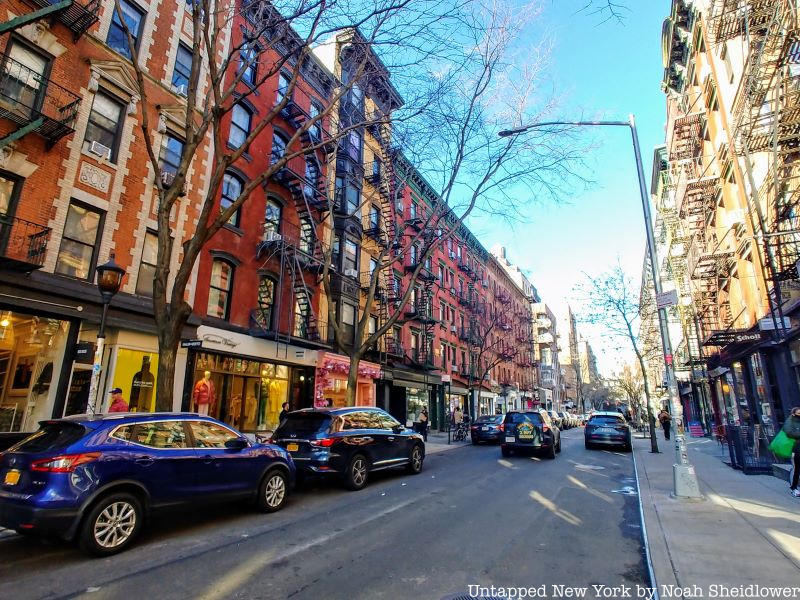
Nolita, derived from “North of Little Italy,” is one of Manhattan’s newest designated neighborhoods. Originally grouped in with SoHo or Little Italy, Nolita has lost much of its Italian presence, though some remnants from over a century ago remain. Nolita is bounded by Houston Street, Bowery, Broome Street, and Lafayette Street, making it one of Manhattan’s smallest neighborhoods. Despite its size, Nolita is a diverse neighborhood – with its own Little Paris, Australia, and Israel – packed with mysterious and fascinating. Here are the top 14 secrets of Nolita!
1. Nolita has its own “Little Paris” as of 2022
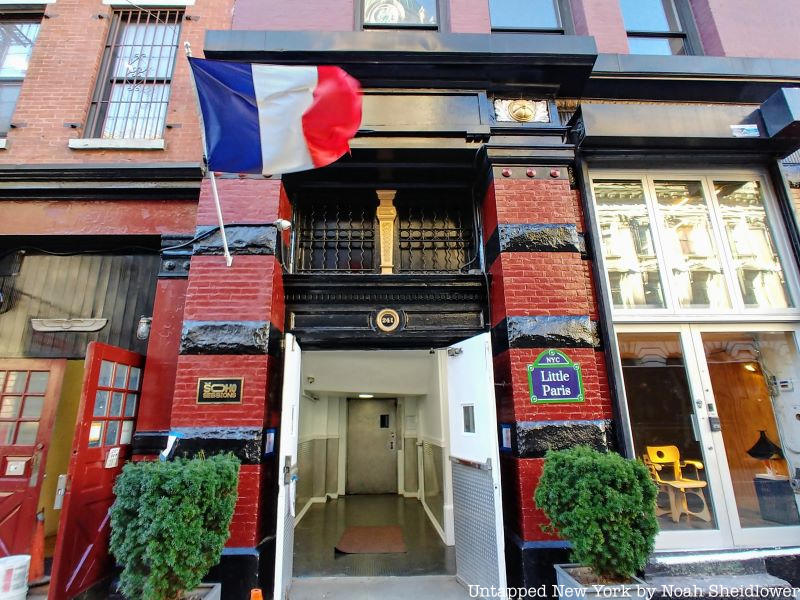
As of 2022, New York City has its own “Little Paris,” located in Nolita. The enclave is located on Centre Street between Broome and Grand Streets, parallel to the fittingly named Lafayette Street, named after the most famous Frenchman to fight in the American Revolution. The effort to designate the new neighborhood has been led by Coucou French Classes, whose founders Léa and Marianne Perret noted that present-day SoHo was in the late 1800s a flourishing quartier français. The heart of Little Paris is located across from the old Police Headquarters Building, which may have been inspired by Paris City Hall, l’Hôtel de Ville.
Maman, at 239 Centre Street, is a popular French café, bakery, and event space, known for dishes including banana-lavender cornmeal waffles with vanilla mascarpone. Deals include a two-for-$10 bundle on its assortment of baked goods, traditional fare like pain perdu, and sophisticated offerings like “un deux trois,” a fig and olive tapenade, and herb-whipped feta with toasted country bread. La Compagnie des Vins Surnaturels, at 249 Centre Street is a sophisticated wine bar designed by Parisian interior designer Dorothée Meilichzon. Further down Centre Street is Clic, a decor and lifestyle store opened in 2008 by Christiane Celle. And of course, Coucou French Classes offers a selection of native-taught courses for learners of all skills.
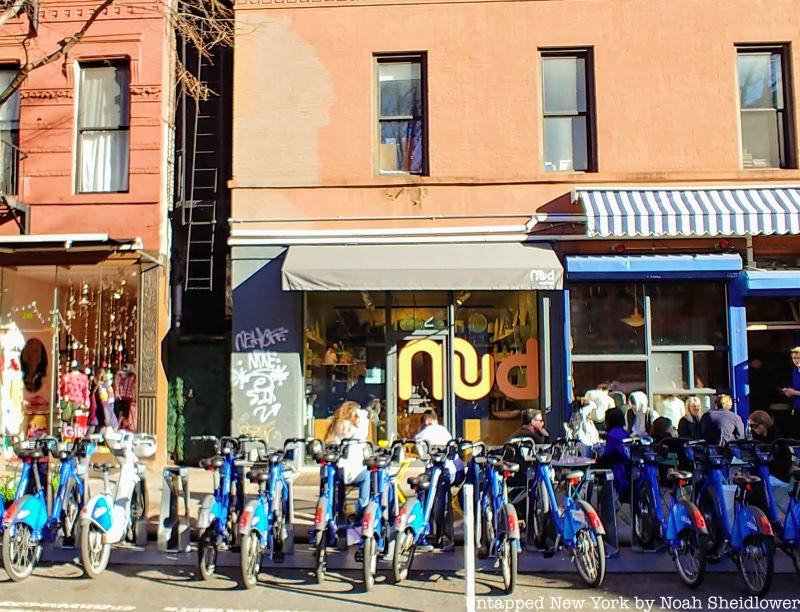
In addition to Nolita’s strong Italian presence and a growing French community, the area also has a small and unofficial Little Australia and Little Israel. On Mott Street, there is an Australian-inspired cafe called Two Hands serving up dishes including mushroom toast and lemon poppyseed waffles. Little Ruby’s Cafe, which opened in 2002, has blended local produce with Australian culinary influences, leading to dishes like vegemite toast, the Bondi burger, and rice bowls. Mud Australia Store, which originally began in Sydney, opened a Nolita location recently, selling dinnerware and home decor. The Flower Shot on Eldridge Street is another Australian-owned business near the neighborhood with options like fish and chips, mushroom rigatoni, and pan-seared salmon.
Though not as large, there is a sizeable Israeli community in Nolita. Shoo Shoo provides a contemporary take on Mediterranean cuisine with an emphasis on the staples of Tel Aviv. Dishes include steak shishlik, shakshuka, harissa burgers, and lamb arayes. Also popular is 19 Cleveland, an Israeli restaurant with an entire section called “From Tel Aviv,” as well as land and sea options taking inspiration more broadly from the Middle East. Taïm, which means “tasty” in Hebrew, is a more fast-casual concept in Nolita with customizable bowls and pitas.
2. Elizabeth Street Garden Houses an Olmsted Gazebo from a Gilded Age Mansion
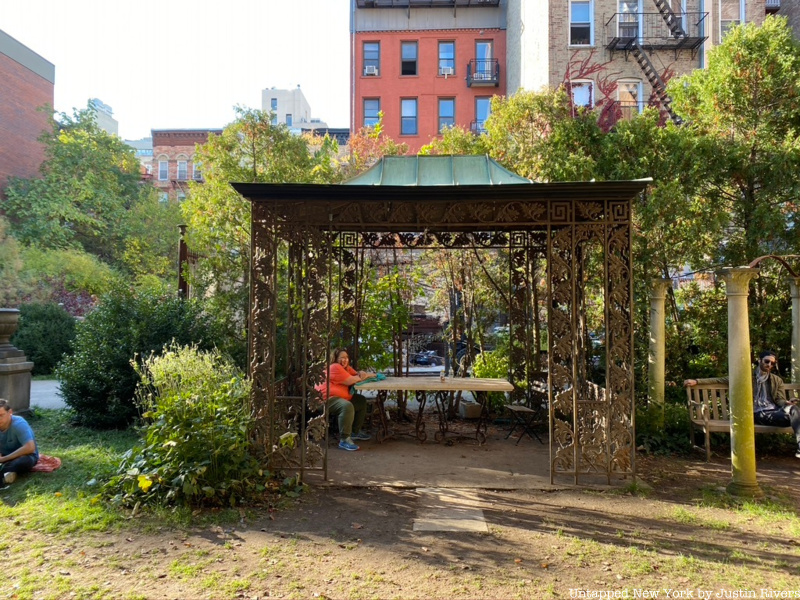
Elizabeth Street Garden is one of the defining features of Nolita. The outdoor space filled with sculptures was created by gallery owner Allan Reiver in 1991 in an abandoned city-owned lot. The garden is known for its eclectic array of sculptures and pieces of architectural salvage, including a small sculpture of a little boy pulling a thorn from his foot. Amid sculptures of lions, Roman columns, and mythological figures is an iron gazebo, which was sourced from a Gilded Age estate like many of the garden’s artworks.
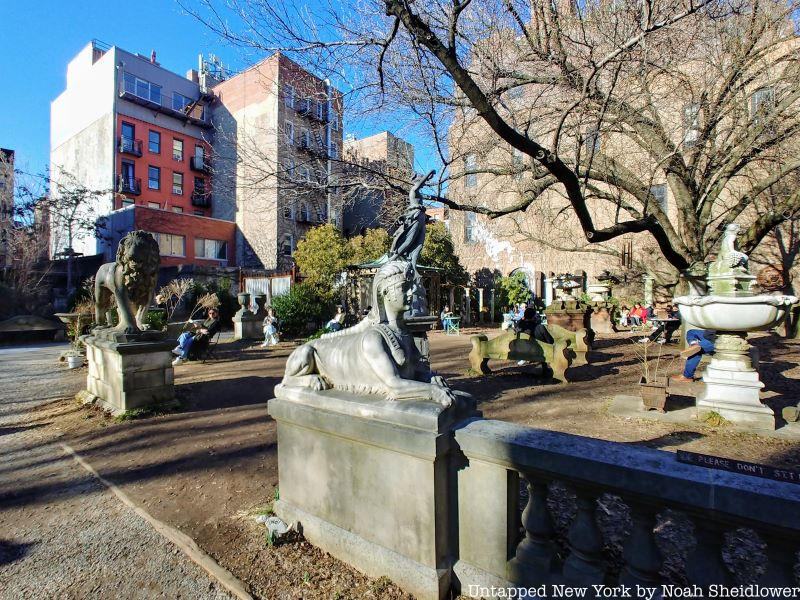
The gazebo has ties to renowned landscape architect Frederick Law Olmsted. When Olmsted passed away, his two sons, John and Frederick Jr., kept the family business alive under the name of Olmsted Brothers. One of their first commissions was at the Burrwood Estate in Cold Spring Harbor, Long Island owned by Walter Jennings, a director and secretary of the Standard Oil Company.
Jennings picked Carrere & Hastings, the architect duo behind the New York Public Library’s main branch, to design his five-story, 50-room mansion. The Olmsted brothers were hired to design gardens on the estate’s 400 acres, including an elaborate iron gazebo now found at the Elizabeth Street Garden. At the estate, the gazebo stood in front of a grassy clearing, framed by a sculpture on either side.
3. 8 Prince Street Had Ties to the Mafia
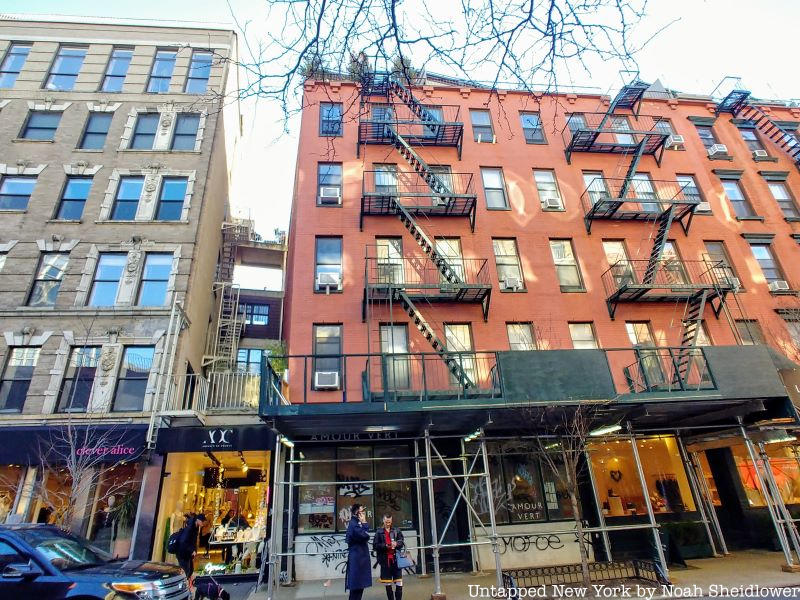
Nolita has its fair share of former Mafia locations, and perhaps the most notable is 8 Prince Street. The building was the site of a spaghetti parlor belonging to Giuseppe Morello, the first boss of the Morello crime family, who was nicknamed “The Old Fox.” Morello, whose right hand had just one finger, ordered death sentences for those who opposed him; it is estimated his main enforcer committed more than 60 murders in 10 years. Morello led operations from the 8 Prince Street shop, which was the site of a particularly gruesome murder. Benedetto Madonia, one of Morello’s counterfeiters, was stabbed to death and stuffed in a barrel. The incident led the NYPD to bring about his downfall.
Right across the street at 9 Prince Street was another important Mafia location, an import market belonging to Lupo the Wolf, otherwise known as Ignazio Lupo. He was a member of the Sicilian Black Hand, running large extortion operations as well as robberies and murders. Lupo merged his crew with others to form the Morello crime family. Lupo, who operated a number of grocery stores in the Little Italy area, was often present at 9 Prince Street, planning operations.
4. Albanese Meats & Poultry is the Last Remaining Spot on Butcher’s Row
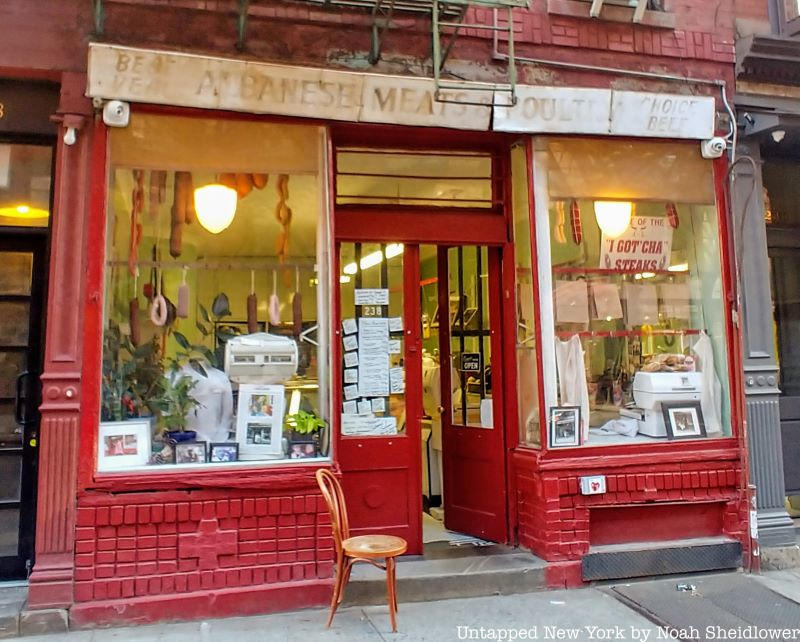
Along Elizabeth Street, which about a century ago was lined with butcher shops, sits the last remaining old-school butcher in the neighborhood, Albanese Meats & Poultry. Celebrating its 100-year anniversary this year, the butcher shop is essentially frozen in time. The shop has retained much of its original form, from the exterior signage to the equipment inside and its lime green walls; its faded signage was actually put up by Francis Ford Coppola for The Godfather Part III. The shop is now owned by Jennifer Prezioso, who is the shop’s fourth-ever employee. Its historic appearance has brought it much attention, including from the director of “The Marvelous Mrs. Maisel” who used the shop as a Jewish butcher shop in the Amazon series.
The block was a popular destination for butchers since nearby Canal Street used to be where cattle were sold. There were at least half a dozen butcher shops predominantly owned by Sicilian immigrants. For decades, the shop was owned by Moe Albanese, who passed away in 2020 just shy of age 96. Prezioso took over the shop after leaving the theater world and learning the ropes at the shop starting in 2017. The shop still retains books of orders from nearly a century ago, as well as other antiques and a prayer to San Gandolfo, the patron saint of the Albaneses’ hometown in Sicily.
5. Lombardi’s was Arguably New York’s First Pizza Spot
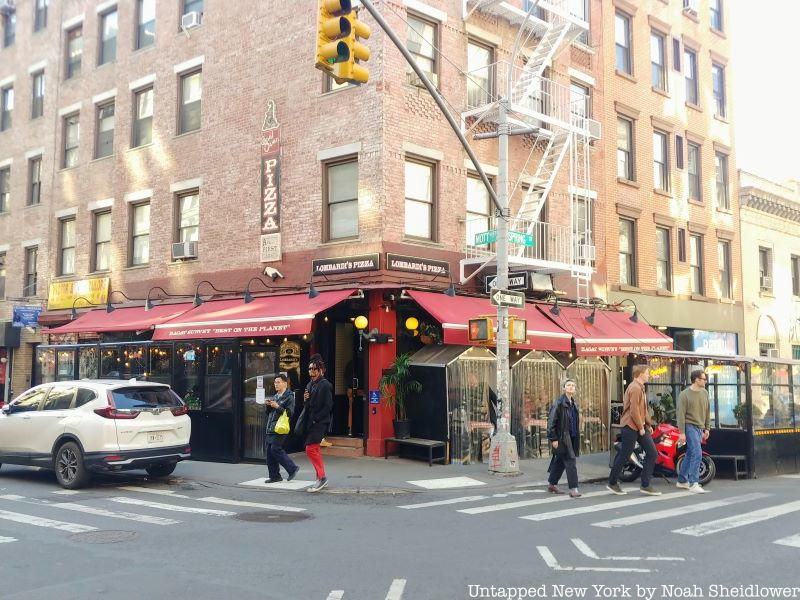
Gennaro Lombardi founded his pizzeria Lombardi’s in 1905 in what would become Nolita, though the area was not the cultural destination it is today. The blocks surrounding Lombardi’s were full of thieves, murderers, and eventually, pizza makers. Of the two million Italians who arrived in the United States from 1900 to 1910, thousands packed themselves into tenement buildings in nearby Five Points. Lombardi’s, 118 years later, is the first pizzeria in the country according to the Pizza Hall of Fame. Lombardi’s closed for about 10 years in 1984, therefore Papa’s Tomato Pies in Trenton is the oldest continually run pizzeria in the country, opened in 1912.
Some debate that Lombardi’s had a predecessor; pizza researcher Peter Regas claims that Filippo Milone established grocery stores that later became pizzerias, and some believe Lombardi adopted one of Milone’s grocery stores. The restaurant has stayed within the family’s ownership since 1905, and Lombardi’s grandson found a location at the corner of Spring St. and Mott St. where the family could reopen Lombardi’s. Lombardi’s uses the same margherita pizza recipe that they gained fame for over a century ago.
6. A Lost Graffiti Exhibit is Hidden Behind the Walls of 11 Spring Street
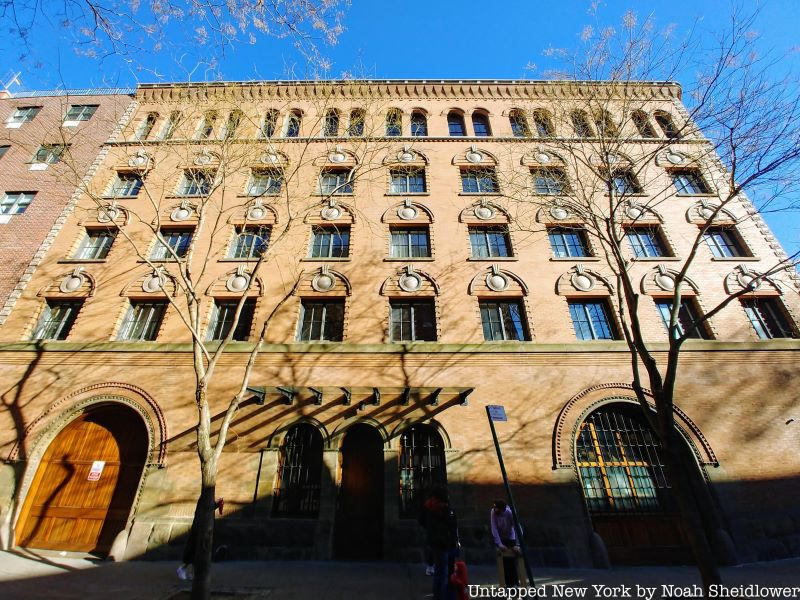
11 Spring Street, among the neighborhood’s architectural gems, has had quite a storied past. Dating back to around 1888, the building gained the nickname “candle building” for its 60 candled windows. Originally serving as horse stables, 11 Spring Street attracted attention from passersby for its facade and ornately draped windows, though it also made itself a target. For decades, the building’s exterior was the canvas for some of the world’s most famous street artists, who splashed the walls with spray paint, metal, plastic, and all sorts of other materials.
Caroline Cummings and Bill Elias, who purchased the building in 2006, wanted to convert it into residential properties, which would require cleaning up the exterior. To pay homage to the dozens of artists who made the building’s exterior their own, Cummings and Elias decided to take over the inside of the building and cover five floors of walls (30,000 square feet) with art. Nearly 45 artists contributed to the temporary project, including Shepard Fairey and D*Face, a London-based artist who proposed to his fiancée by painting the question on 11 Spring Street. Though much of the art was covered by drywall, the building remains a historic site for arts and culture in the neighborhood.
On the northern edge of Nolita, at the intersection of Bowery and Houston Street, is the Houston Bowery Wall, another remnant of the neighborhood’s graffiti art scene. The famed mural wall has displayed work by notable New York artists ever since Keith Haring created a large mural on it in 1982. Haring was not the first to use the wall for graffiti, but his mural pulled people into the area more than any other. The wall was then acquired by Goldman Properties in 1984, which used it to display advertisements that would constantly be vandalized.
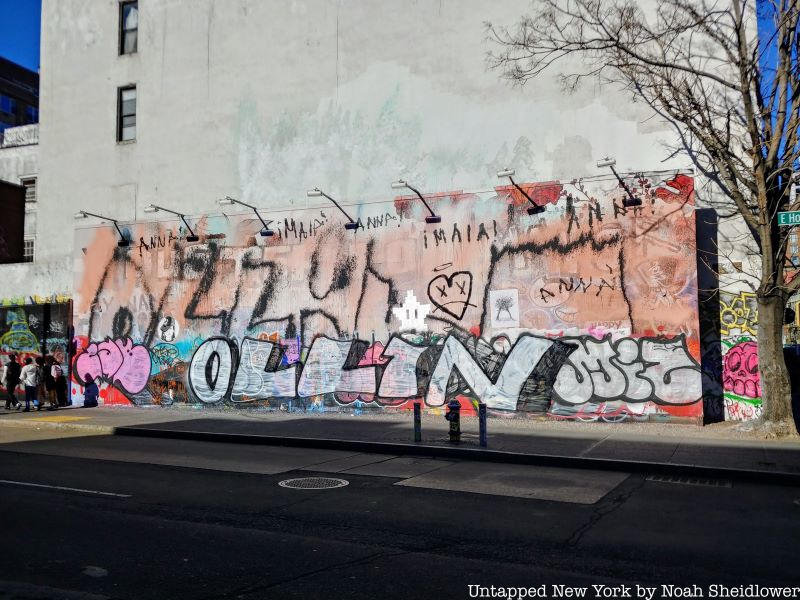
Over two decades later, the wall became a popular art spot again in 2008 when art dealer and curator Jeffrey Deitch was given permission to commission new pieces every six to 12 months. Since then, dozens of street artists have displayed their art on the wall, including Shepard Fairey (who designed the Barck Obama “Hope” poster), Kenny Scharf, and JR (whose installation focused on guns in America). Banksy had a 2018 piece on the wall about the imprisonment of an artist by the Turkish government. Unfortunately, because of high levels of vandalism, the wall’s owners announced a pause on any new murals.
7. The Puck Building used to House a Political Satire Magazine
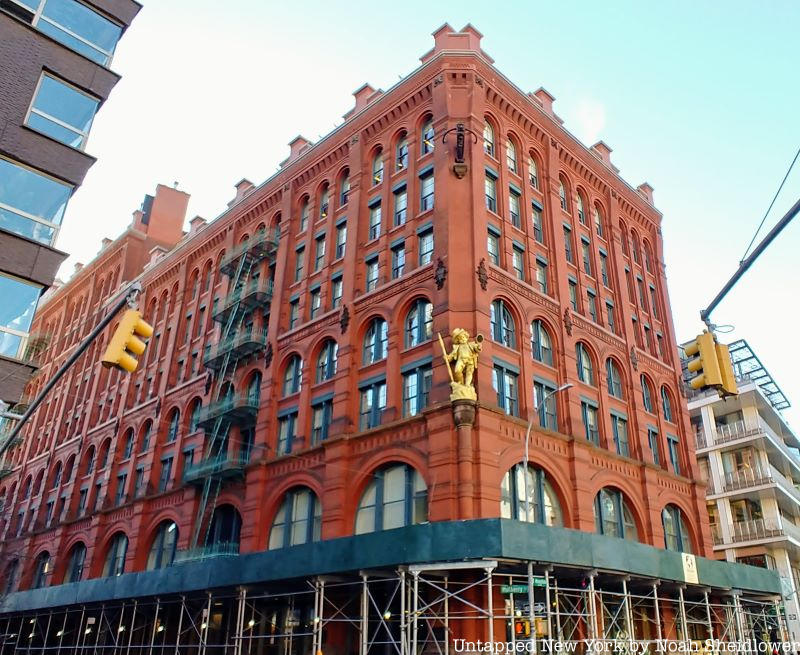
One of the defining buildings of Nolita is the Puck Building, which was built in the round-arch style (or Rundbogenstil in German). The large building, bounded by Lafayette, Houston, Mulberry, and Jersey Street, was the masterpiece of
Albert Wagner. It was constructed between 1885 and 1886. A year after its completion, the satirical magazine Puck moved in. The magazine, founded in 1876 in St. Louis, covered issues like Tammany Hall and took its name from a character in Shakespeare’s play A Midsummer Night’s Dream. The magazine gained fame for depictions of presidents and major political figures, New York political bosses, and foreign politicians.
The same year Puck moved in, a major fire destroyed the magazine’s editorial rooms; another fire took place later that year causing $50,000 in damages. As Puck recovered and grew its reader base, other major printing and ink companies moved into the building. Alger Hiss, who was accused of spying for the Soviet Union, got his start as a salesman for stationery company S. Novick & Son, which was based on the building’s second floor. The magazine shut down in 1918, and slowly tenants left, leading to plans to convert the building into residences.
8. St. Patrick’s Old Cathedral was NYC’s Roman Catholic Cathedral Before St. Patrick’s Cathedral in Midtown
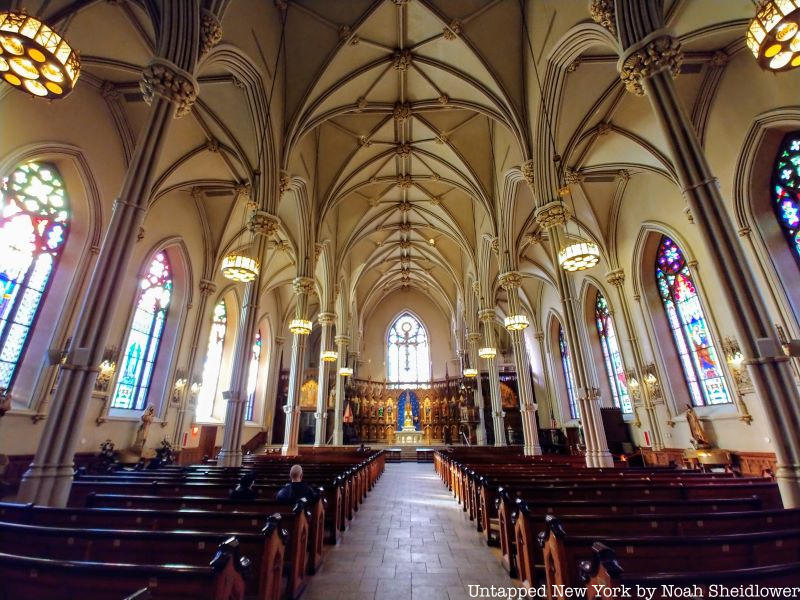
Though many New Yorkers immediately point to St. Patrick’s Cathedral in Midtown as the city’s Roman Catholic cathedral, this was not always the case. St. Patrick’s Old Cathedral, located on Mulberry Street between Prince and Houston Streets, was the seat of the Archdiocese of New York until 1879. Though not the first Roman Catholic church in the city (that title belongs to St. Peter’s Church in the Financial District), it was built as a second sanctuary for the city’s growing Catholic population. At the time, the church was built amid acres of farmland. The church’s architect, Joseph-Francois Mangin, had co-designed City Hall and led construction efforts between 1809 and 1815.
For the first two decades, the church was the ending point for the city’s St. Patrick’s Day parade. The church was almost sacked in 1836 after escalating tensions between Irish Catholics and anti-Catholic Know-Nothings. Two years later, Mozart’s primary librettist, Lorenzo da Ponte, had his funeral here. The cathedral burned down in 1866 but was rebuilt within the next year. The basilica hosts a series of secret catacombs with 35 family crypts and five clerical vaults.
9. Elizabeth Street Gallery is located in the former G. La Rosa & Son bakery
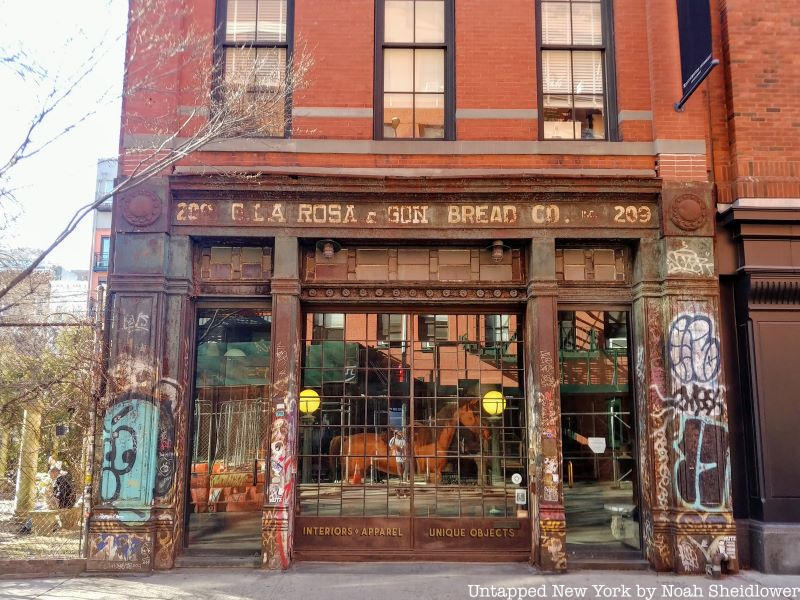
At 209 Elizabeth Street, there is a sign that has survived for decades after the closure of its bakery G. La Rosa & Son Bread Company. The 1850s building is a renovated firehouse, and its facade has remained mostly the same over the past few decades. According to the blog Bobo and Chichi, the bakery catered to movies including The Godfather. The cannoli from the movie, immortalized by the line “leave the gun and take the cannoli,” was prepared by the bakery.
Today, the building is occupied by Elizabeth Street Gallery. The collection includes items such as a folk art stand selling for $75,000, a vintage Louis Vuitton leather luggage set, and a 1910 sundial sculpture among its featured items. The gallery sells everything from gates and fencing to case pieces to lead urns and mirrors.
10. David Bowie, Martin Scorsese, and John Mayer Have All Called Nolita Home
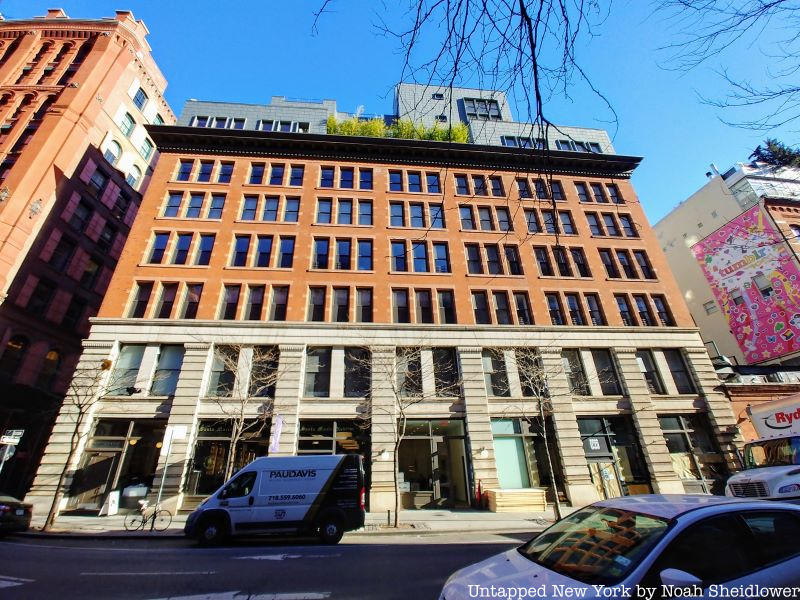
Perhaps expectedly, given the neighborhood’s history and strong arts culture, Nolita has been a hotspot for celebrities over the past few decades. One of the most famous residents of Nolita was David Bowie, who lived in a four-bedroom, 4.5-bathroom condo on Lafayette Street. The home, which sold for $16.8 million, was purchased in 1999 and was where Bowie lived with his wife Iman until passing away in 2016. Another apartment on Lafayette Street was owned by John Mayer, who purchased the two-bedroom, 2.5-bathroom condo in 2005. He eventually sold the 2,063-square-foot home in 2013. Other celebrities who lived at 225 Lafayette have included Tyra Banks and Dakota Fanning.
One of the area’s former residents decades ago was Martin Scorcese, who grew up at 232 Elizabeth Street. The building was occupied mostly by immigrants from Sicily and was often called Cirmina, a town outside Palermo; the building across the street was mainly occupied by immigrants from another town near Palermo called Pulizi. Many of the residents along Elizabeth Street ran businesses in the neighborhood, including butcheries and bakeries. Scorcese recalled Mary the Butcher, who was still working into her 90s, as well as Mr. Torminelli’s grocery store. The opening shot of his film Who’s That Knocking at My Door depicts the view from his grandmother’s window.
11. The Fourteenth Ward Industrial School was Designed for the Children’s Aid Society
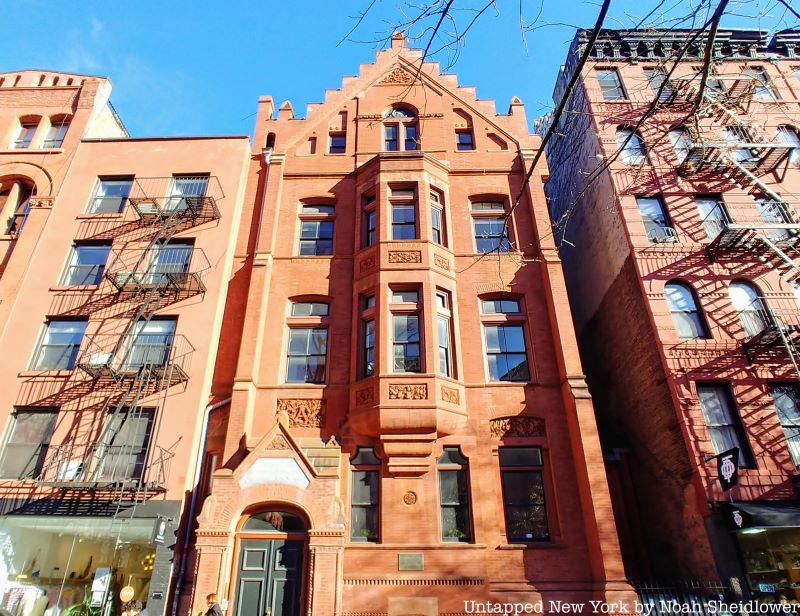
One of the older buildings in Nolita is the former Fourteenth Ward Industrial School, dating back to 1888. Also referred to as the Astor Memorial School, the building was constructed for the Children’s Aid Society. It was designed by the architecture firm Vaux & Radford in the Victorian Gothic style. The building was opened about three decades after the founding of the Children’s Aid Society by Charles Loring Brace. At the time, abandoned and orphaned children lived in New York’s slums and on the streets, and Brace opened centers to educate and train children for employment while breaking them from their pasts. The program was met with some hesitation from abolitionists and Catholics.
The Fourteenth Ward Industrial School was the first Children’s Aid Society building planned solely as a school. The school was in operation until 1913 when it relocated to a larger building on the corner of Elizabeth and Hester Streets. The building was soon after named the Mulberry Community Center, which provided English language classes and medical clinics. It was later sold to the Fourteenth Ward Industrial Building, Inc., which converted the building into residential apartments.
12. The Feast of San Gennaro is Almost 100 Years Old
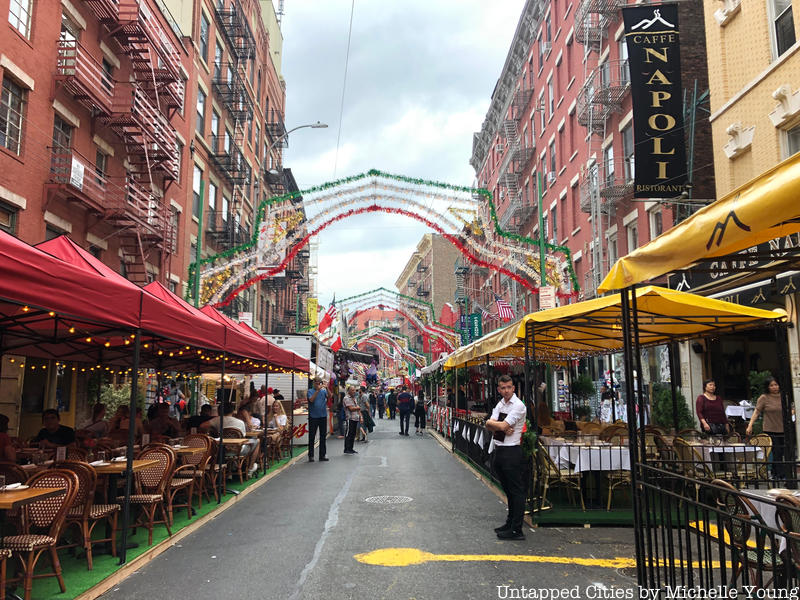
The Feast of San Gennaro is an annual celebration of Italian American culture and cuisine centered along Mulberry Street in Little Italy and Nolita. The festival was first celebrated in the United States in September 1926 after immigrants from Naples erected a small chapel on Mulberry Street to house an image in honor of Januarius — Gennaro in Neapolitan Italian — the patron saint of their hometown. The group consisted mainly of cafe owners who had moved to the neighborhood in the prior decades. Those who came to pray were asked to pin an offering to the ribbon streamers hanging from the statue’s apron. Money gathered from the festivity was subsequently distributed to the poor in the neighborhood.
The festival has since grown into an 11-day street fair with food vendors, carnival games, live music, and other attractions. On the last Sunday of the feast, after a celebratory mass at the Church of the Most Precious Blood, a Grand Procession takes place, during which a statue of San Gennaro is carried through the streets of Little Italy. Sausage and peppers and zeppoles are popular dishes sold by street vendors, while a cannoli-eating contest annually takes place outside the famous Ferrara Bakery & Cafe. The festival has also been immortalized in The Godfather Part III, in which Vincent Corleone assassinates Joey Zasa during the festival.
Next, check out the Top 10 Secrets of NoHo!





